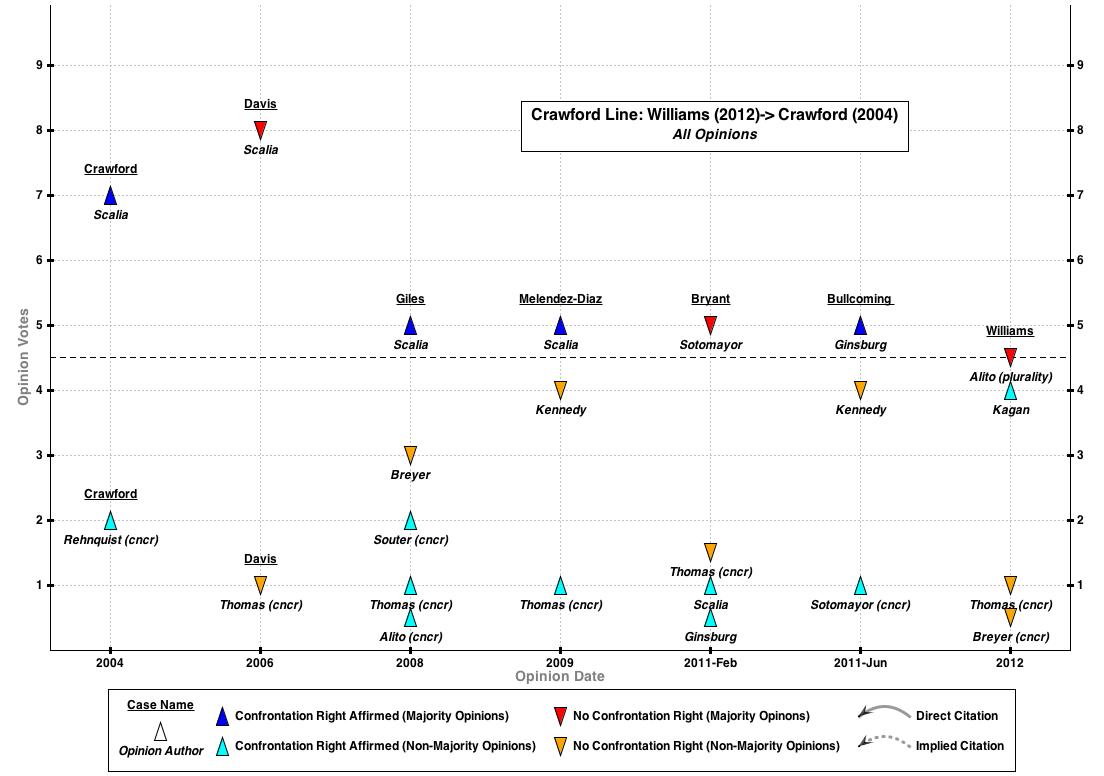This is the fourth installment in a series of blog posts charting out Confrontation Clause doctrine since 2004’s Crawford v. Washington. Last time, I deployed a Spaeth visualization to illustrate how the early doctrinal consensus around Crawford has collapsed. Today we introduce individual Justices into the picture, graphically illustrating the proposition that the Court’s authority derives from its authors.
The above map depicts the majority opinions in the Crawford line with opinion authors noted below the opinions. The Y-axis indicates the number of votes each opinion received. Note how counting votes for an opinion differs from counting votes for judgment. Thus, while judgment was unanimous in Crawford, the map shows that two justices did not join Justice Scalia’s opinion. More dramatically, though five justices endorsed judgment in 2012’s Williams decision, only four justices joined Justice Alito’s plurality opinion. This map confirms that Crawford doctrine lacks consensus.
Before considering one more map, I want to point out a potential error in this first one. The potential error is with the Supreme Court Database (Spaeth) coding. The map represents cases with Spaeth-coded “conservative” outcomes with red triangles; blue-triangles thus represent Spaeth-coded “liberal” outcomes. Now, Spaeth codes the 2008 case Giles v. California as conservative. I think this is an error since Giles rather controversially vacated a pro-state/anti-defendant outcome. In other words, Giles was a victory for the criminal defendant, which should qualify as “liberal” under Spaeth’s rubric. I have therefore re-coded Giles — see below:
The map above displays as individual points the complete set of 23 opinions in the Crawford line (7 majority + 10 concurrences + 6 dissents). The number of votes received for all the opinions is again displayed on the Y-axis. Please note, however, that the Y-positions had to be tweaked slightly in two cases with multiple one-vote opinions (Giles [Thomas, Alito], Bryant [Thomas, Scalia, Ginsburg], and Williams [Thomas, Breyer]). Finally, Justice Alito’s four-vote plurality opinion in Williams also has its Y-value tweaked to distinguish it from Justice Kagan’s four-vote dissent.
This complicated picture portrays many voices straining to be heard in the constitutional conversation. In the past decade, ten different justices have authored Crawford-line opinions. Except for Chief Justice Roberts, every currently sitting justice has stated his or her views at least once. Some have prolifically contributed to the debate. Justice Scalia, for example, has penned a dissent in addition to his four majority opinions. This is perhaps unsurprising since Justice Scalia was the prime architect of the early doctrine. More unexpectedly, Justice Thomas has also written five opinions, all concurrences. (More on that next time).
While there’s much to chew on here, there is also work yet to be done. Next time I’ll connect the individual data points above via citations. This will reveal “competing lines” in the doctrine and allow us to better visualize the evolution of Confrontation Clause jurisprudence over the last decade.
UPDATE: The original version of this post incorrectly stated that Justice Alito’s plurality opinion in Williams garnered three votes. It actually garnered four. The text and map have been changed to reflect this. HT George Fisher.


